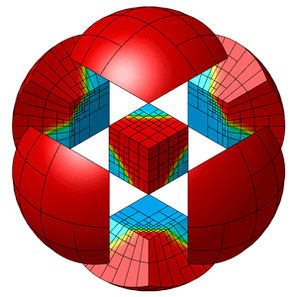MFEM
 The logo of MFEM shows some of its features: curvilinear elements, adaptive mesh refinement and parallel partitioning. | |
| Stable release |
3.4
/ May 29, 2018 |
|---|---|
| Repository | https://github.com/mfem/mfem |
| Written in | C++ |
| Operating system | Linux, MacOS, Microsoft Windows |
| Type | Finite element analysis |
| License | LGPL version 2.1 |
| Website |
mfem |
MFEM is an open source C++ library for solving partial differential equations using the finite element method, developed and maintained by researchers at the Lawrence Livermore National Laboratory. MFEM is free software released under the GNU Lesser General Public License (LGPL-2.1).[1]
The library consists of C++ classes that serve as building blocks for developing finite element solvers applicable to problems of fluid dynamics[2], structural mechanics[3], electromagnetics[4], radiative transfer[5] and many others.
MFEM is part of the Center for Efficient Exascale Discretizations in the Exascale Computing Project, the FASTMath institute in the SciDAC program, the Extreme-scale Scientific Software Development Kit, and the OpenHPC distribution.
Features
Some of the features of MFEM include[6]
- Arbitrary high order finite elements with curved boundaries.
- H1, H(curl) and H(div) conforming, discontinuous (L2), and NURBS finite element spaces.
- Local mesh refinement, both conforming (simplex meshes) and non-conforming (quadrilateral/hexahedral meshes).
- Highly scalable MPI-based parallelism.
- Tight integration with the Hypre parallel linear algebra library.
- Many built-in solvers and interfaces to external libraries such as PETSc, SuperLU, SuiteSparse, SUNDIALS, etc.
- Accurate and flexible visualization with GLVis and VisIt.
- Lightweight design and conservative use of C++ templating.
- Documentation in the form of examples and mini-applications.
See also
References
- ↑ Auten, Holly. "The High Value of Open-Source Software" (PDF). Science & Technology Review. January/February 2018: 5–11.
- ↑ Anderson, Robert W.; Dobrev, Veselin A.; Kolev, Tzanio V.; Rieben, Robert N. (2018). "High-Order Multi-Material ALE Hydrodynamics". SIAM Journal on Scientific Computing. 40 (1): B32–B58. doi:10.1137/17M1116453.
- ↑ White, D. A.; Stowell, M. L.; Tortorelli, D. A. (2018). "Topological optimization of structures using Fourier representations". Structural and Multidisciplinary Optimization: 1–16. doi:10.1007/s00158-018-1962-y.
- ↑ Shiraiwa, S.; Wright, J. C.; Bonoli, P. T.; Kolev, T.; Stowell, M. (23 October 2017). "RF wave simulation for cold edge plasmas using the MFEM library". 22 Topical Conference on Radio-Frequency Power in Plasmas. 157: 03048. doi:10.1051/epjconf/201715703048.
- ↑ Holec, M.; Limpouch, J.; Liska, R.; Weber, S. (10 April 2017). "High‐order discontinuous Galerkin nonlocal transport and energy equations scheme for radiation hydrodynamics". Numerical Methods in Fluids. 83 (10): 779–797. doi:10.1002/fld.4288.
- ↑ "MFEM - Finite Element Discretization Library".